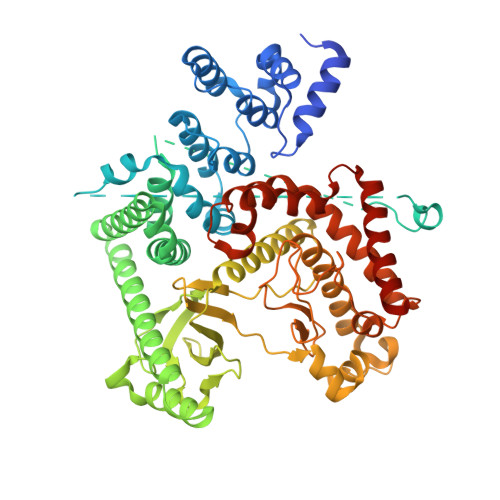Structure-Based Design of Potent, Selective, and Orally Bioavailable VPS34 Kinase Inhibitors.
Hu, D.X., Patel, S., Chen, H., Wang, S., Staben, S.T., Dimitrova, Y.N., Wallweber, H.A., Lee, J.Y., Chan, G.K.Y., Sneeringer, C.J., Prangley, M.S., Moffat, J.G., Wu, K.C., Schutt, L.K., Salphati, L., Pang, J., McNamara, E., Huang, H., Chen, Y., Wang, Y., Zhao, W., Lim, J., Murthy, A., Siu, M.(2022) J Med Chem 65: 11500-11512
- PubMed: 34779204
- DOI: https://doi.org/10.1021/acs.jmedchem.1c01180
- Primary Citation of Related Structures:
7RSJ, 7RSP, 7RSV - PubMed Abstract:
VPS34 is a class III phosphoinositide 3-kinase involved in endosomal trafficking and autophagosome formation. Inhibitors of VPS34 were believed to have value as anticancer agents, but genetic and pharmacological data suggest that sustained inhibition of VPS34 kinase activity may not be well tolerated. Here we disclose the identification of a novel series of dihydropyrazolopyrazinone compounds represented by compound 5 as potent, selective, and orally bioavailable VPS34 inhibitors through a structure-based design strategy. A water-interacting hydrogen bond acceptor within an appropriate distance to a hinge-binding element was found to afford significant VPS34 potency across chemical scaffolds. The selectivity of compound 5 over PIK family kinases arises from interactions between the hinge-binding element and the pseudo-gatekeeper residue Met682. As recent in vivo pharmacology data suggests that sustained inhibition of VPS34 kinase activity may not be tolerated, structure-activity relationships leading to VPS34 inhibition may be helpful for avoiding this target in other ATP-competitive kinase programs.
- Pharmaron Beijing Co., Ltd., 6 Taihe Road, BDA, Beijing 100176, China.
Organizational Affiliation:




















